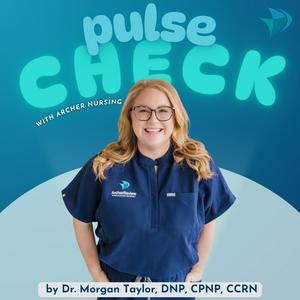81 episodes

EP 81 - Jaundice
12/23/2025 | 20 mins.
In this episode, Dr. Morgan Taylor, DNP, CPNP, CCRN breaks down newborn jaundice, one of the most common (and often misunderstood) conditions you’ll see in mother–baby, pediatrics, and on exams. We walk through why newborns turn yellow, how bilirubin is produced and cleared, and—most importantly—how to recognize when jaundice crosses the line from normal physiology to a true emergency. Using a real-world bedside scenario, this episode helps you connect the pathophysiology to what you actually see and do as the nurse. This episode is essential for nursing students, new grads, and anyone caring for newborns who wants to feel confident distinguishing “normal yellow” from “act now.” If you’re prepping for exams or clinicals—and want jaundice to finally make sense—this one’s for you. Find everything Archer Review has to offer: archerreview.link/PulseCheck Use code PULSECHECK10 - an exclusive discount just for our listeners! Connect with us! 📸 Instagram: @archernursing 📘 Facebook: Archer NCLEX Review 🎵 TikTok: @archernursing ▶️ YouTube: Archer Review NCLEX, USMLE, TEAS7, and FNP

EP 80 - Superior Vena Cava Syndrome
12/16/2025 | 17 mins.
In this episode, Dr. Morgan Taylor, DNP, CPNP, CCRN breaks down superior vena cava (SVC) syndrome, a true oncologic emergency that nurses must recognize and act on quickly. Using clear anatomy, memorable analogies, and a high-yield case study, this episode walks through why SVC syndrome happens, what it looks like at the bedside, and how to prioritize nursing interventions when the airway is at risk. This episode is essential for nursing students, new grads, and bedside nurses caring for oncology or respiratory patients. If you want to feel confident identifying life-threatening complications early—and knowing exactly when to drop everything and act—this episode is for you. Find everything Archer Review has to offer: archerreview.link/PulseCheck Use code PULSECHECK10 - an exclusive discount just for our listeners! Connect with us! 📸 Instagram: @archernursing 📘 Facebook: Archer NCLEX Review 🎵 TikTok: @archernursing ▶️ YouTube: Archer Review NCLEX, USMLE, TEAS7, and FNP

EP 79 - What to Do Over Winter Break (to Actually Recharge)
12/09/2025 | 19 mins.
In this special episode, Dr. Morgan Taylor, DNP, CPNP, CCRN shifts the focus from pathophysiology and case studies to something nursing students rarely pause to examine: their own nervous system. Instead of diving into shock, sepsis, or cardiac rhythms, Morgan walks you through how to approach winter break with intention—by giving yourself permission to rest, decompress, and reset without guilt. What you’ll learn: • Why your body “crashes” after finals and what real recovery looks like • The difference between numbing activities and restorative rest • Four types of rest—physical, mental, emotional, and social—and how to choose what your brain actually needs • How to build a simple, realistic winter break reset plan you can follow without burnout • Gentle ways to prep for next semester without sacrificing your downtime This episode is perfect for any nursing student heading into break exhausted, overwhelmed, or unsure how to balance rest with productivity. If you’re craving permission to recharge—and a clear, compassionate plan to start next semester feeling grounded—this is the one to tune into. Find everything Archer Review has to offer: archerreview.link/PulseCheck Use code PULSECHECK10 - an exclusive discount just for our listeners! Connect with us! 📸 Instagram: @archernursing 📘 Facebook: Archer NCLEX Review 🎵 TikTok: @archernursing ▶️ YouTube: Archer Review NCLEX, USMLE, TEAS7, and FNP

EP 78 - Multiple Sclerosis
12/02/2025 | 17 mins.
In this episode, Dr. Morgan Taylor, DNP, CPNP, CCRN breaks down multiple sclerosis by zooming in on the nervous system’s “electrical wiring” and what happens when the immune system attacks the myelin coating that keeps signals fast, smooth, and efficient. Through clear analogies and a real case study, you’ll understand why symptoms vary so widely, how relapses and remissions develop, and why heat and fatigue are such powerful triggers. This episode is perfect for nursing students reviewing neuro disorders, NCLEX® learners needing a quick but thorough breakdown of MS, and new nurses seeking practical teaching points for clients managing chronic neurologic conditions. A high-yield listen with clear explanations you can use right away. Find everything Archer Review has to offer: archerreview.link/PulseCheck Use code PULSECHECK10 - an exclusive discount just for our listeners! Connect with us! 📸 Instagram: @archernursing 📘 Facebook: Archer NCLEX Review 🎵 TikTok: @archernursing ▶️ YouTube: Archer Review NCLEX, USMLE, TEAS7, and FNP

EP 77 - Osteoporosis
11/25/2025 | 16 mins.
In this episode, Dr. Morgan Taylor, DNP, CPNP, CCRN breaks down osteoporosis by starting at the source—how healthy bones remodel themselves through the balance of osteoblasts and osteoclasts, and what happens when that balance shifts. You’ll walk through the hormonal players (estrogen, PTH, calcitonin, and vitamin D), why post-menopausal clients are highest risk, and how bone density loss leads to vertebral compression fractures, height changes, and increased fracture risk. Through a real-world case study, you’ll connect symptoms like shrinking height and back pain to DEXA results, lab findings, and the nursing priorities that follow. This episode is especially helpful for nursing students learning musculoskeletal disorders, NCLEX® test-takers reviewing chronic conditions and safety priorities, and new-to-practice nurses who need clear teaching points for patients managing bone health at home. A quick listen with high-yield takeaways—no cramming required. Find everything Archer Review has to offer: archerreview.link/PulseCheck Use code PULSECHECK10 - an exclusive discount just for our listeners! Connect with us! 📸 Instagram: @archernursing 📘 Facebook: Archer NCLEX Review 🎵 TikTok: @archernursing ▶️ YouTube: Archer Review NCLEX, USMLE, TEAS7, and FNP
More Education podcasts
Trending Education podcasts
About Pulse Check with Archer Nursing
Listen to Pulse Check with Archer Nursing, Mick Unplugged and many other podcasts from around the world with the radio.net app

Get the free radio.net app
- Stations and podcasts to bookmark
- Stream via Wi-Fi or Bluetooth
- Supports Carplay & Android Auto
- Many other app features
Get the free radio.net app
- Stations and podcasts to bookmark
- Stream via Wi-Fi or Bluetooth
- Supports Carplay & Android Auto
- Many other app features


Pulse Check with Archer Nursing
download the app,
start listening.







































